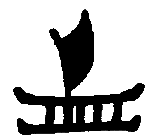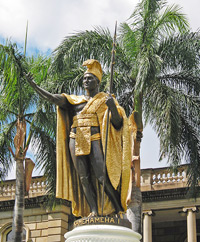
Article
Kamehameha: King of War and Peace
by Serge Kahili King
 For those of you who have heard the name, Kamehameha the Great, but don't know anything about him, here is a very short presentation of highlights from the life of this most remarkable man.
For those of you who have heard the name, Kamehameha the Great, but don't know anything about him, here is a very short presentation of highlights from the life of this most remarkable man.
He was born on the Big Island of Hawaii, in the northern Kohala District. According to some sources, it was a night of thunder and lightning and "a red star like the falling rain is red when the sun shines through it." It was a time of war and chiefly rivalries, and his life was in deadly danger from the moment he was born.
Not much is know about his early life, and perhaps that's why he was given a name which means "The Lonely One." There is one legend that, while still a young man, he fulfilled a prophesy which said that whoever could lift, or turn over, two huge boulders somewhere on the Hilo side would someday conquer the islands. Of course, Kamehameha lifted, or turned them over, easily, and the rest is history. Two large boulders, supposedly the same ones, used to sit in front of the Hilo Public Library, but I didn't notice them the last time I went.
The first modern account we have of his existence is when he was a member of the retinue of the then reigning king of Hawaii Island when the latter visited Captain James Cook aboard his ship in 1779. After that, he was more and more "in the news" as we would say today.
When the old king died and his heirs fought over the kingdom, Kamehameha decided it was time to unify the whole island chain. It took fifteen hard years of ferocious battles, with the help of Western advisors, ships and weapons, and, according to one Hawaiian source, regiments of women archers, plus good diplomacy, to complete the task. Hawaii Island, Maui, Molokai, and Oahu were conquered outright, but peace with Kauai had to be negotiated.
Kamehameha was not just a conqueror, he was a man of vision and practicality. Unlike previous winners of wars in Hawaii, he refused to allow the slaughter of commoners after a battle, and he even helped the conquered peoples to rebuild their economy, thus gaining lasting loyalty amond the common people. One piece of far-reaching legislation he imposed was called "The Law of the Splintered Paddle," named after an incident in his youth. This law guaranteed the safety of all who traveled between the districts on all the islands. At a time when greedy chiefs and outlaws often preyed on travelers, especially women, children, the sick, and the aged, it was a very welcome law.
As he settled down to create a peaceful nation, one of the things he did was to help design and then approve the very first flag of Hawaii, whose basic form is still used today. It has the English Union Jack in one corner, because the English were great friends of Hawaii in those days, and the eight stripes represent the eight major islands. The original purpose of the flag was to enable Hawaiian ships to sell sandalwood in China, because the Chinese would not deal with any ship without a national flag.
Kamehameha died in May of 1819. No one knows how old he was, because no one truly knows when he was born. And, in keeping with ancient tradition, no one knows where his bones were buried.
You can, however, get a tiny idea of what he might have looked like. Here on Big Island there is a statue representing him in Hilo and in Kohala. There is another one in Honolulu, and still another in Washington, D.C. He was a man for Hawaiians to be proud of, and for all others to admire.
[Top of page] - Contact us